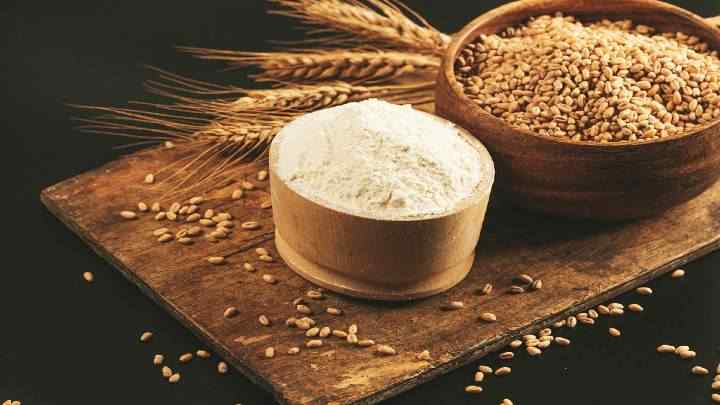Wholemeal, whole wheat and whole grain flour are terms that are used interchangeably in various countries.
Whole grain flour refers to wholemeal flour in the UK while you can term it as whole wheat or whole grain flour in the United States. However, they have a slight difference from one another.
This article explores the differences, health benefits, uses, and similarities between the wholemeal and whole wheat flour.
What is wholemeal flour?
Wholemeal flour comes from whole grains that have undergone milling to give a fine brown texture and appearance.
This type of flour contains more dietary fiber when compared to refined white flour. It also possesses more minerals and vitamins than products made using refined white flour.
In terms of glycemic index, wholemeal products are much lower than white bread.
However, unlike whole wheat flour which consists of whole grain wheat, wholemeal flour uses other whole grains like corn, rye, barley, etc.
What is whole wheat flour?
Whole wheat flour is a powdery basic food ingredient derived from mashing or grinding the whole grain of wheat (wheatberry).
A majority of the products baked today make use of whole wheat flour. It also may sometimes be mixed with lighter refined white flours which have been treated with flour bleaching agents.
Mixing whole wheat flour with white flour during the baking process helps to replenish every nutrient (protein, vitamins, and flour), that the white flour loses during the milling or bleaching process.
Can you substitute whole wheat flour with wholemeal flour
Yes, you can substitute whole wheat flour with wholemeal flour as they are almost identical.
Wholemeal and whole wheat represent names given to full grain-related products in different countries. While the United States makes use of Whole Grain or Whole Wheat in their naming, the UK makes use of the term “Wholemeal”.
Although they share similar definitions especially when the base ingredient is wheat, there are some differences between them.
What differences exist between whole wheat and wholemeal flour?
The major difference between whole wheat and wholemeal is the type of grain being used.
Whole wheat flours exclusively refer to flours that contain the complete wheat kernel. This means that whole wheat flour products contain the entire wheat kernel.
On the contrary, wholemeal flour can refer to any whole grain used in making the flour such as; wheat, rice, millet, corn, quinoa, rye, sorghum, teff, and triticale.
So while whole wheat refers to the complete and exclusive milling of the wheat kernel in making the flour, wholemeal flour may include the use of other grains.
SEE: The Unique Differences Between Maida and All-Purpose Flour
How are whole wheat flour and wholemeal flour similar?
Both wholemeal and whole wheat contains all three components of the grain used. This is also known as the caryopsis and they include the germ, bran, and endosperm.
Germ
Germs contain fats, vitamins, and antioxidants and are the reproductive portion of a wheat kernel.
Bran
The bran is the fibrous external layer of the kernel. It is rich in minerals and B vitamins.
Endosperm
This is the largest portion of the wheat kernel and comprises mostly carbohydrates. Refined white flours or bread flours use mostly the endosperm.
Note that when the entire kernel of a grain is used (depending on the type of grain), the product can be termed whole wheat, wholemeal or whole grain.
Wholemeal flour vs whole wheat flour: which is better?
Wholemeal is better than whole wheat as it is not limited to wheat. Other grains can be used in making wholemeal flour, hence making it suitable for people who are intolerant to gluten or wheat and need products made using gluten-free flours.
Whole wheat flour vs wholemeal flour: which is healthier?
Since both whole wheat and wholemeal flours contain the entire kernel, they are equally healthy and nutritious.
If, however, you have a gluten intolerance or a corn allergy, you should purchase wholemeal flour that does not contain these grains.
Also when it comes to eating baked products, it is important to choose those made of whole wheat or whole meal flour as they possess the most nutrients. White flours after refining possess only the endosperm, and as such do not have much nutrients or fiber.
Wholemeal and whole wheat flours in addition to enough dietary fiber, contain healthy fats, minerals, and vitamins which you can find in the bran and germ of the kernel.
Studies have also shown that products made with whole grains help lower the risk of type 2 diabetes, heart diseases, and other health conditions.
SEE: Gluten-Free Flours You Didn’t Know Are Just Good as Wheat Flour
Is wholemeal flour better than bread flour?
Yes, wholemeal flour is better than bread flour as it contains the complete nutritional benefits associated with milling the entire grain kernel.
In contrast, bread flour only contains the endosperm, lacks the same health benefits, and is low in fiber and other nutrients.
What are the uses of whole wheat or wholemeal flour?
Wholemeal or whole wheat flour mostly serves in the production of pasta, pastries, bread, cookies, crackers, and flatbread like tortillas, pita, naan, roti, etc.
SEE: Bread vs Cake: Differences, Uses, And Types
FAQs
Can wholemeal bread cause indigestion?
Yes, wholemeal bread can cause indigestion or acid reflux, if you eat them in excess or suffer from gluten sensitivity.
Can wholemeal bread flour work for cakes?
Yes, you can substitute wholemeal bread flour for all-purpose flour to bake a cake and other pastries. However, the result will not be the same as that made with all-purpose flour and will not produce the desired texture.
Will wholemeal bread make me fat?
Wholemeal bread won’t make you fat unless you consume them in excess. In fact, wholemeal bread is great for those who are on a diet as it contains few calories.
Conclusion
The truth is that there’s a lot of confusion about the whole wheat flour vs. wheat meal debate. Whether it’s based on culture, nutrition, or both, some people are convinced that wholemeal and whole wheat are one and the same.
The big difference between these two types of flour lies in what type of grain they consist of. However, grinding the bran, germ, and endosperm together to make wholemeal flour and whole wheat flour results in a final product with a higher nutritional value compared to regular flour.
Still, it’s important to remember that many other factors go into making nutritious bread besides just the type of flour used. This includes how the preparation and the kind of ingredients used.
Find out what makes whole wheat flour healthier than bread flour and why bread flour is commercially utilized in making bread despite not being as healthy as wholemeal or whole wheat flour.
I hope you found this article helpful. Thanks for reading.






